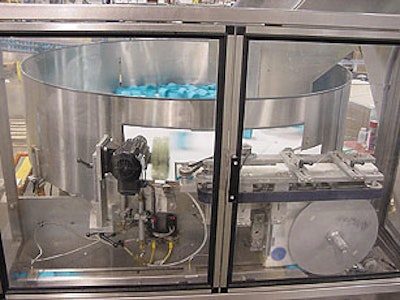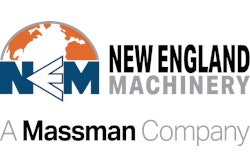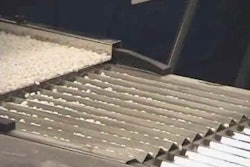While ladder climbing is desirable in the business world, it’s not so good for packaging production. Due to problematic overcap feeding, that’s exactly what operators at Unilever HPC’s Raeford, NC, plant, were having to do to free equipment jams 24 hours daily.
The cap feeding system was jamming frequently as it had to sort and feed sizes of overcaps that it wasn’t intended to handle. Jams became so frequent that an employee was perched full-time atop a ladder to clear the machinery, according to Philip Sheets, project specialist.
That all changed in July ’99 with a revamped arrangement of the overcap hopper/sorter/orienter/feeder. It features new equipment from New England Machinery (Bradenton, FL), including sorter, orienter and an air conveyor that transfers the overcaps to the capper. The machinery was provided through the assistance of distributor Allison Packaging Systems (Simpsonville, SC).
“As we added different sizes of cans and as the overcap size changed, we found that sorter was unable to keep up with line speeds,” Sheets explains. The company, then part of Chesebrough-Ponds, had run only 205-size overcaps, corresponding to 8.5-oz cans. Starting about three years ago, 202 and 211 sizes of overcaps, corresponding to 7- and 14-oz cans, were added. The overcaps top steel aerosol cans of Rave, Aqua Net and Suave-brand hairsprays.
Before, Unilever was hampered by the slow speed of the cap feeder. Worse, it was jamming every five minutes, Sheets estimates. Now, the improved line cruises jam-free ’round-the-clock at a consistent rate of more than 200 overcaps/min —that’s 22% above the old rate.
Improved ergonomics
In addition to being faster and more reliable, the revamped setup is more ergonomic, says Sheets.
The polypropylene overcaps, from Berry Plastics (Evansville, IN), are unloaded from corrugated cases into a hopper. Unilever made use of a larger hopper procured from elsewhere in the plant. The hopper holds three cases of overcaps, rather than the one case before, thus reducing operator time to unload the overcaps. The hopper gives Unilever about 30 minutes run time, Sheets estimates.
The new hopper is situated so that the height required to dump the cases is, at 36’’ high, 6” lower than before. Full cases weigh about 12 lb each, Sheets says.
From the hopper, a 6’-long inclined conveyor transports the overcaps into the new 60’’ diameter stainless-steel sortation bowl, which is mounted 6’ above floor level. The old bowl was mounted at a 45° angle with a 6’-high centerline, Sheets says. Thus, the discharge point that often needed jam-clearing attention was about 9’ above floor level.
The overcaps are sorted by inertia from a spinning central disc, made of UHMW polyethylene, at the bottom of the stationary bowl. Overcaps are propelled to the bowl edge where they fit into a gap between the edge of the disc and the bowl that’s sized to the overcap run. Overcaps fit end to end into this gap. Airjets are positioned to dislodge overcaps not seated in the gap back onto the spinning disc for resorting; a paddle wheel near the discharge propels upright overcaps out of the way that have made it that far.
At the bowl exit, overcaps are captured by side belts that carry them from the bowl and then transfer them onto a vertically rotating disc with two sides. Held between the two discs, the overcaps pass by a hook that catches on the edge of inverted ones to upright those.
Overcaps then release onto a 6’’-wide, 6’-long air conveyor that carries them to the capper infeed. The air flow helps speed the overcaps on their way to the capper because gravity flow alone was not fast enough.
Rare jams
This section to the capper was another aspect that has been greatly improved, says Sheets. The previous setup consisted of a metallic twist section that turned the overcaps 180°. Sheets says this had been another frequent source of jams, but that jams anywhere on this new equipment are now rare. And if there is one, it’s easily fixed from floor level, he adds.
Changeovers of overcap size are made infrequently, maybe one per month, Sheets says. “We try to run a single overcap size on this line, but when there is a changeover on this equipment, it’s tool-less and takes only 20 minutes.” What’s required is changing out the plastic sorter disc, which is sectional, and adjusting it to preset markings.
Labor savings result from the elimination of the ladder-perched operator. Sheets believes this has contributed to a six-month return-on-investment.
The bottom line for Unilever is that it is considering a similar setup on other lines for its in-line capping needs.
Sheets says the biggest challenge to the entire project was a design that allowed it to fit into the existing space of the old system, which had been a tight fit. The startup was so straightforward as to be “push the button and go,” says Sheets. “Operators loved it.”
Recalling the ladder, one could say Unilever was floored by the improvement.






























